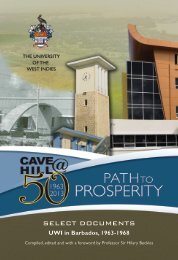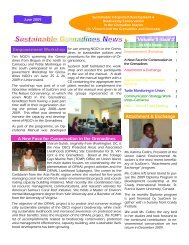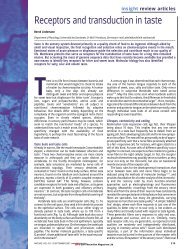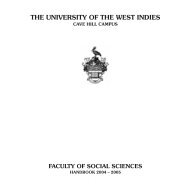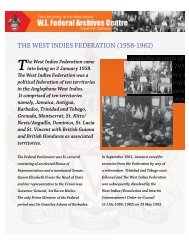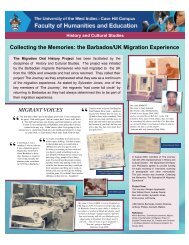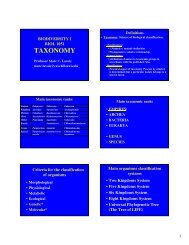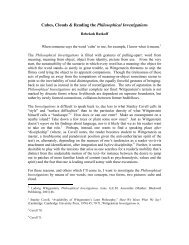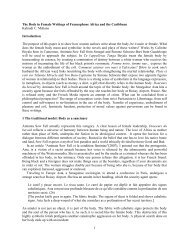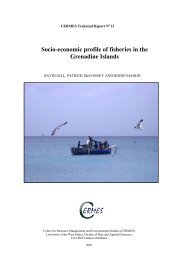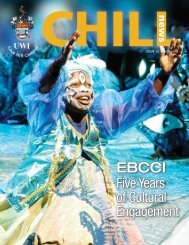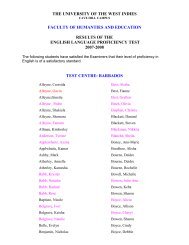THE SUSTAINABLE GRENADINES PROJECT - The University of ...
THE SUSTAINABLE GRENADINES PROJECT - The University of ...
THE SUSTAINABLE GRENADINES PROJECT - The University of ...
You also want an ePaper? Increase the reach of your titles
YUMPU automatically turns print PDFs into web optimized ePapers that Google loves.
Petit Martinique unique. This book is easy to read, well set out and very informative, but its best quality is how the writer<br />
manages to convey his pride <strong>of</strong> his home.<br />
Clive A.F. 1976. <strong>The</strong> Grenadines from Columbus to Today- the settlement <strong>of</strong> St. Vincent and the Grenadines. Cole's<br />
Printery for Consultant Sales & Marketing, Bridgetown. 40 pp.<br />
This is yet another interesting look at Grenadine society. As with many similar texts, it highlights the influence <strong>of</strong> the sea<br />
on Grenadine society and contains information on Whaling, Boat-building and Fishing. In addition to this it discusses the<br />
interpretation <strong>of</strong> dreams, the Big Drum, and the role <strong>of</strong> the Church and Education.<br />
Comley, J., M. Mason, K. Cordice, and P. Raines. 2002. Tobago Cays marine biodiversity conservation project.<br />
Summary report. Coral Cay Conservation Ltd., London. 21 pp.*<br />
A total <strong>of</strong> 112 survey dives by Coral Cay Conservation volunteers, equating to 276 man-survey-hours surveyed 6.12<br />
kilometres <strong>of</strong> the reefs within the Tobago Cays Marine Park. Field data collected during this period has been split into<br />
survey areas to enable better management <strong>of</strong> the data: Worlds End and Egg Reef, Horseshoe and Petit Tabac Reefs, Tobago<br />
Cays, Mayreau Island. Full quantitative habitat descriptions and biodiversity assessments are given in this report for those<br />
habitats found. Worlds End and Egg reef are largely extant calcareous reef platforms with low biological cover. Horseshoe<br />
and Petit Tabac support good communities <strong>of</strong> live coral and associated communities, though there is evidence in the data<br />
collected to indicate this area is undergoing a possible phase shift from coral to macro algae dominated communities. <strong>The</strong><br />
area around the Tobago Cays supports a low diversity <strong>of</strong> habitats, which in themselves are low in biodiversity. <strong>The</strong>re is<br />
evidence however to indicate that this area is important in maintaining the diversity and productivity <strong>of</strong> the surrounding reef<br />
areas. <strong>The</strong> coastline around Mayreau Island and in particular the area known as Mayreau Gardens supports habitats with the<br />
highest diversity <strong>of</strong> all found in this study. Key management outcomes from this summary report are the need for focussed<br />
protection in the areas outlined, such as Mayreau Gardens, alongside monitoring for continued evidence <strong>of</strong> change in the<br />
biological communities as attributable to human impact.<br />
Constantine, S., S. Singh-Renton and L. Straker. 2003. <strong>The</strong> Red Hind Fishery <strong>of</strong> St. Vincent and the Grenadines- An<br />
interview Study. pp 146-160. In: CRFM (eds.) Report Of <strong>The</strong> 2002 Joint Meeting Of <strong>The</strong> CRFM Large Pelagic<br />
Fisheries Working Group (CRFM LPWG), <strong>The</strong> CRFM Reef And Slope Fisheries Working Group (CRFM RSWG),<br />
And <strong>The</strong> CRFM Small Coastal Pelagic Fisheries Working Group (CRFM SCPWG). CARICOM Fishery Report No.<br />
10.*<br />
<strong>The</strong> red hind is the most important reef fish species landed in the small scale artisanal fishery <strong>of</strong> St. Vincent and the<br />
Grenadines. <strong>The</strong> document reports on a survey conducted to gather information on the characteristic, spatial and temporal<br />
distribution <strong>of</strong> the red hind fishery and to determine the relationships between length and weights <strong>of</strong> the red hind caught in<br />
St. Vincent and the Grenadines waters. <strong>The</strong> survey targeted red hind fishers on the mainland <strong>of</strong> St. Vincent and also Bequia.<br />
According to Constantine et al, the information gathered from the study <strong>of</strong>fers fishery managers the information needed to<br />
begin the development <strong>of</strong> management plans for the red hind fishery. In addition, it highlights that fishers need to be<br />
educated about not only to protect the resources but also the environment that the resource depends upon.<br />
Cooke, M.G. 1980. Report on Roads, Drainage, Runway and Services. Report prepared for the Mustique Company.<br />
32 pp.<br />
Not seen.<br />
Cooke, A. 2005. A Livelihood Analysis <strong>of</strong> the Water Taxi Operators in the Grenadines. Centre for Resource<br />
Management and Environmental Studies (CERMES) UWI. Barbados. 13 pp.*<br />
This article summarizes the results <strong>of</strong> a livelihoods analysis <strong>of</strong> the water taxi operators (WTops) in the Grenadine Islands <strong>of</strong><br />
Grenada and St. Vincent and the Grenadines. <strong>The</strong> natural resources <strong>of</strong> the area, including the many beaches, reefs and cays,<br />
especially the Tobago Cays Marine Park (TCMP) are the resource base for their operation. <strong>The</strong>se resources form part <strong>of</strong><br />
their natural assets according to the definition by the Department for International Development (DFID). Given the<br />
importance <strong>of</strong> the natural resources to the water taxi operators, their potential for environmental stewardship may be<br />
realized through the monitoring <strong>of</strong> the same yachts that they supply. <strong>The</strong>y can ensure, possibly through co-management <strong>of</strong><br />
the Park, that their natural assets are not undermined by a sector that is poorly regulated. <strong>The</strong> other livelihood assets are<br />
15



